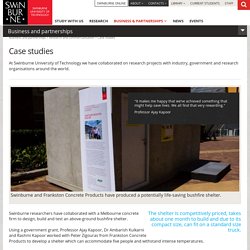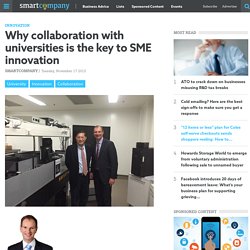

How small businesses can collaborate with universities. Last year small- and medium-sized enterprises spent £193m working with higher education institutions in the UK, but that pales in comparison to the public sector, charities and social enterprises who invested £1,288m to access the latest in research, innovation and graduate talent.

Most relationships between universities and businesses are based around collaborative research projects, but there are many ways for you to get involved with researchers, entrepreneurs and young talent. Here are five reasons why you should get in touch with your local university. 1. Universities can help you find the best graduates By getting involved with a higher education institution you have the ability to shape the future – for your business and for everyone. Universities often offer professional development and staff training to help give your existing team skills. 2. Small businesses spent £49m in 2011 to access university equipment, but not everyone knows what's out there. 3. 4. 5. Research and commercialisation. At Swinburne University of Technology we have collaborated on research projects with industry, government and research organisations around the world.

The shelter is competitively priced, takes about one month to build and due to its compact size, can fit on a standard size truck. Swinburne researchers have collaborated with a Melbourne concrete firm to design, build and test an above-ground bushfire shelter. Using a government grant, Professor Ajay Kapoor, Dr Ambarish Kulkarni and Rashmi Kapoor worked with Peter Zigouras from Frankston Concrete Products to develop a shelter which can accommodate five people and withstand intense temperatures.
Swinburne’s researchers provided knowledge on design and human factors to complement expertise from the shelter’s manufacturers. In the event of a bushfire, people move into the inner chamber of the shelter where they close the vents and wait out the fire. The Sanctuary Bushfire Shelter is now for sale through Frankston Concrete Products. Collaboration case studies - Working with the University, The University of York.
Why collaboration with universities is the key to SME innovation - SmartCompany. Some of the greatest assets available to Australian SMEs and large companies lie untapped.

A recent OECD study shows Australia is lagging embarrassingly far behind other developed economies when it comes to active collaboration between universities and business. We are 18th on the ladder, with only 3.5% of large companies and 4.1% of small and medium size firms reported to be collaborating with universities or public research organisations. Finland tops the list with 70% and 29% respectively. Yet universities and other research organisations have so much to offer business with the capacity to unlock potential through innovation. Why the reluctance to get together? There are many reasons for this. In fact, universities are an Aladdin’s cave of opportunities and innovation. Fortunately, as a former small business owner, I was more aware than most of the potential. Take Swinburne University of Technology’s Factory of the Future, which is part of its Advanced Manufacturing and Design Centre. SME–University collaborations: Creating mutual benefits. Lars Olsson Entrepreneur Successful collaboration between academic research groups and industry is normally, by the outside, associated to R&D activities.

For small and medium sized enterprises (SME), acting on non-research intense markets, collaboration of such kind may therefore seem very far away or even irrelevant. The involved partners in an academic–industry collaboration, often rather refer to the mutual benefits of such relationship. For instance: Academic researchers may get access to information, data or infrastructure while the non-academic partner gets access to advice, specific knowledge, or students as future employees. A well-known research group within the field of sustainable electric power production led by Professor Ola Carlson at Chalmers has a lot of collaborative projects together with large multinational companies. It all started when Lars Olsson became CEO at Falbygdens Energi AB (FEAB). When theory meets practice “It is easy. SME academia cooperation presentation. SMEs and Universities – Collaboration Can Bring Benefits to All.
The maps, along with a report to HEFCE by the Enterprise Research Centre (ERC) entitled ‘Collaboration between SMEs and universities – local population, growth and innovation metrics’, are intended to help drive collaboration with small businesses by supporting universities and colleges in identifying opportunities to work with more small business, and to understand and contribute further to the local economy.

Madeleine Atkins, HEFCE Chief Executive, is keen for universities to be at the “centre” of the development of city regions and localities. The benefit for SMEs and to the local economy could be invaluable but universities need to work hard to be accessible to business owners and business owners need to understand more about how universities can help them. Madelaine Atkins said, on the release of the new maps: Professor Stephen Roper, Director of the Enterprise Research Centre and Professor of Enterprise at Warwick Business School, said: companies.